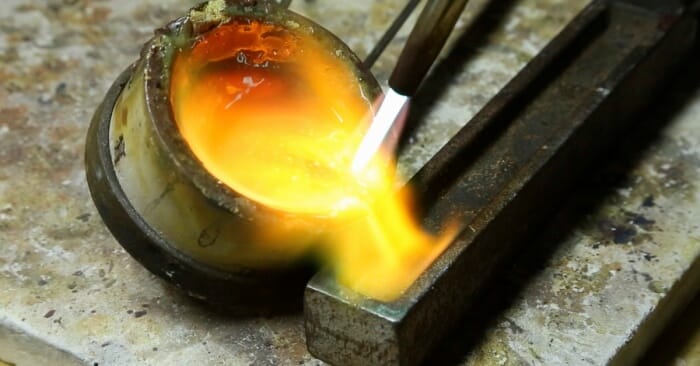We have all heard of precious metals, but what exactly are they, and what earns them the right to be called precious?
In this beginner’s guide to precious metals, we’ll look at some of the top precious metals you might encounter and what you need to know about them.

What Are Precious Metals?
Precious metals are rare, naturally occurring chemical elements. They have high economic value and some of them like gold and silver served as currency in the past. Precious metals have intrinsic value and are regarded as investment and industrial commodities.
What Does Intrinsic Value Mean?
Intrinsic value is when the worth of an object is derived in and of itself.
For example, if gold trades for $1,800 per troy ounce, a coin minted from one troy ounce of gold would have an intrinsic value of $1,800. Note that intrinsic value isn’t the same as market value.
If it’s a very rare coin, it’s market value may be well above $1,800. If it has to be melted down, it’s market value will be less than $1,800 taking smelting and other costs into account.
What Metals Are Precious?
There are eight elements or commodities that are recognized as precious metals. They are:
Gold, silver, and the six platinum-group metals – ruthenium, rhodium, palladium, osmium, iridium, and platinum.
The three most popular precious metals are gold, silver, and platinum.
Gold
Gold is arguably the most popular precious metal, but there’s often a lot of confusion about it.
How It’s measured
Gold is measured by the troy ounce, which is equivalent to 31.1034 grams. A troy ounce should not be confused with a “regular” ounce that weighs only 28.3495 grams.
Gold Purity
The purity of gold is measured in karats with pure gold being 24 karats. Since gold is very soft and malleable, items such as jewelry are never made using pure gold.
In the United States, most jewelry has a purity of 14 karats and sometimes 18 karats.
14 karats = 58.3% pure gold.
18 karats = 75.0% pure gold.
The balance of 41.7% and 25.0% respectively is typically a mixture of other metals like copper, zinc, silver and nickel. These other metals add strength to the jewelry so it’s less likely to break.
Colors
Pure 24 karat gold always has a yellow color. However, by mixing gold with other alloys (metals) different colors can be created.
Examples:
Rose Gold
Rose gold is a gold-copper alloy.
The most common alloy contains 75% gold and 22.25% – 25.00% copper (a small amount of silver is often added) which makes 18k rose gold.
White Gold
Many people mistakenly believe that white gold and platinum are the same thing. However, this is not the case.
White gold was originally developed to imitate platinum (a naturally white metal). White gold is usually an alloy containing 75% pure gold and 25% white metals such as nickel, silver, zinc, or palladium.
Gold is mostly used in the manufacture of jewelry.
Silver
Silver may be scarce compared to many other elements, but it’s the most abundant and least expensive precious metal. It’s often a byproduct when mining for gold, copper, lead, and zinc.
How It’s Measured
Like gold, silver prices are typically quoted by the troy ounce which is 31.1034 grams.
Silver Purity
Silver is available as either fine silver or sterling silver.
Fine silver (often called pure silver) is the purest form of silver. It contains 99.9% silver and 0.1% trace elements. There are no elements or metals added to it after the refining process.
Sterling silver is an alloy containing 92.5% pure silver and 7.5% other metals like copper, nickel, or zinc. The harder metals added to it makes it much stronger than fine silver.
Uses of Silver
Besides jewelry, silver has a wide range of applications. Since it’s the best thermal and electrical conductor of all the metals, it’s ideal for electrical applications. It’s also widely used in the medical field due to its antimicrobial properties.
Note: Fine silver is hypoallergenic so fine silver jewelry shouldn’t cause any skin reactions. However, if nickel is added to create sterling silver jewelry, it might cause skin irritations as some people are allergic to it.
Platinum
Platinum is a naturally white metal and is the best known and most widely used of the six platinum-group metals. It’s a dense, highly unreactive metal. Its name is derived from the Spanish term platino or “little silver”.
How It’s Measured
Like other precious metals, platinum prices are typically quoted by the troy ounce which is 31.1034 grams.
Platinum Purity
Platinum jewelry rarely contains 100% pure platinum. It typically has either 90% or 95% pure platinum. The remaining 5% or 10% is usually metals like palladium, ruthenium, iridium, rhodium, copper, or cobalt.
Uses of Platinum
Platinum is often used in jewelry due to its strength and because it doesn’t lose its lustre. Many people also like the fact that it’s very rare and durable. And because it’s such a dense metal it has a gratifying, weighty feel.
However, it’s main use is in catalytic converters for cars, trucks and buses. It’s also widely used in the electronics industry.
Conclusion
Precious metals are rare, naturally occurring chemical elements that have high economic value.
The eight elements that are recognized as precious metals are gold, silver, and the six platinum-group metals – ruthenium, rhodium, palladium, osmium, iridium, and platinum.
There are many sites such as BullionVault where you can find spot prices for precious metals and track their historical performance.
We trust that after reading this article you will have a better understanding of precious metals.
If you have any jewelry made from precious metals that you would like to sell, pawn, or have evaluated, Maxferd has in-house experts who are ready to assist you.
Call us at (800) 888-7296 or visit one of our five locations in San Francisco and Los Angeles to find out how we can help you.

